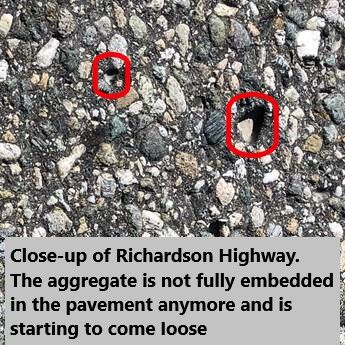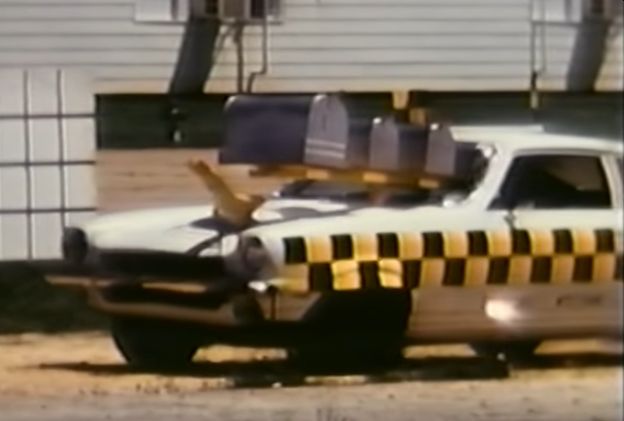Richardson Highway MP 329-340 Pavement Preservation Project No. NFHWY00583 / 0714(027)
We are planning a highway pavement preservation project on the Richardson Highway between mileposts 329 and 340. The purpose of this project is to extend the service life of the existing asphalt, and to provide safer driving conditions.
The first stage of construction will be accomplished by the Department’s Maintenance and Operations section. They will perform “crack banding” to smooth out the existing road surface.
The second stage, including the installation of “chip seal”, will be performed by a contractor. The purpose of chip seal is to protect the pavement from the effects of sun and water, increase its skid resistance, and fill small cracks or other defects.
The contractor will be also replacing road signs and mailboxes. Learn more about why we are replacing mailboxes below.
What is crack banding?
Crack banding is the application of an asphalt material, composed of tiny rocks, over the existing pavement. Its purpose is to seal cracks and level the roadway surface.

What is chip seal?
Chip seal is applied by spraying heated asphalt liquid onto the existing pavement. The liquid is then coated with small aggregate (“chips”) which are compacted into the surface.

Why are we replacing the existing mailboxes?
The Department’s goal is to provide safe transportation for all users.
In the past few decades, significant improvements have been made to roadside safety: breakaway sign posts, breakaway light bases, and embankments that allow a vehicle to recover back onto the roadway, or to stop safely within the “clear zone”.
Mailboxes are often located very close to the roadside, and are therefore a potential hazard to any vehicle that leaves the roadway. The Department’s standards for mailbox installation were developed after testing numerous designs to ensure occupant safety and to minimize damage to the vehicle.
We understand that many people are quite satisfied with their current mailbox, however those owners may not be aware of the safety hazard these mailboxes pose to the traveling public.
Crash tests were conducted on several styles of mailboxes. Safety of the driver is one of the aspects considered, another aspect is whether displacing the mailbox on impact could pose risk to the nearby traffic.
Potential Dangers from improperly installed mailboxes:
- Having to withstand the snow removal operations of the roadways, many mailbox owners use various techniques to ensure the mailbox will remain standing year round. An errand vehicle striking a mailbox that is firmly secured may cause the vehicle to overturn or be severely damaged if the mailbox assembly acts as a fixed object.
- While a mailbox may give away upon a vehicular impact, if not installed to the crash tested standards, the mailbox or part of the assembly could get displaced and pose serious threat to the vehicles on the nearby roadways.
- Grouping mailboxes on horizontal board could result in serious injury or death. Images from the crash testing video below show what happens when the simulation vehicle strikes a mailbox post in which is a horizontal wooden board holding multiple mailboxes:
- Vehicle strikes the post which breaks, leaving the horizontal wooden board pretty close to its original horizontal position
- The wooden board holding the mailboxes penetrates the windshield at a height of the upper part of the front seat occupant. In this demonstration the mailboxes enter the inside of the vehicle as well.
- The horizontal board continues to penetrate the inside of the vehicle, going through the space that would be occupied by the front seat occupant.



The video below shows crash testing of various styles and supports of mailboxes.
Although the mailbox supports must adhere to a specific design, you can supply any mailbox container that meets United States Postal Service (USPS) requirements or ask to have your existing USPS approved mailbox installed on the new base, assuming the mailbox can be removed from its original support without damaging it. If you would like to supply your own approved mailbox, please email ivet.hall@alaska.gov before January 31, 2021 to ensure this request is included in the construction contract.
After the new mailboxes are installed by the contractor, your existing mailbox will be removed from its current base and placed underneath your new box. After two weeks, unclaimed boxes will be disposed of by the contractor.
Some mailboxes may be installed further from the existing travel lanes. The project team is currently working with USPS regarding final placement of the mailboxes.
How will new mailboxes benefit you?
Mailboxes and supports that meet our specifications are less likely to cause injury or death if a vehicle leaves the road. Take a look at the sidebar for some crash testing videos.
When a mailbox meeting the Department’s standards is damaged by a snowplow, the mailbox will be replaced by our maintenance staff at no charge to you.
Please contact us with any questions/concerns you have either by contacting the project manager at (907)451-5386 or by writing an email to: ivet.hall@alaska.gov.
Our project staff is currently working on finalizing the design. Construction on this project is expected to begin in June 2022.
This project is being developed in cooperation with the Alaska Division of the Federal Highway Administration in addition to the Department of Transportation and Public Facilities.
Contact Information
If you have questions or comments about the project, please contact:
Ivet Hall, P.E.
DOT&PF Northern Region
2301 Peger Rd Fairbanks, AK 99709-5316
![]() 451-5386
451-5386
![]() Ivet.Hall@alaska.gov
Ivet.Hall@alaska.gov
For individuals requiring TTY communications, please contact Alaska Relay at 7-1-1 or 1-800-770-8973.
More Information
- Crash Test Footage from the Texas Department of Transportation
- Alaska Design and Construction Standards for Mailbox Supports
PLEASE NOTE: Adobe Acrobat PDF files require a free viewer available directly from Adobe.
